 As the world dwells on Industry 4.0, Indian industry takes a step forward every day towards becoming a manufacturing powerhouse. The use of the term ‘Electronics of Things’ is becoming prevalent. It reminds us that no matter how smart devices get, electronics remains their backbone. Under this new series of articles, we will visit the different states in our country and find out how they are stepping up to make India a global ESDM hub. In the very first article in our State Focus series, we turn the spotlight on Uttar Pradesh.
As the world dwells on Industry 4.0, Indian industry takes a step forward every day towards becoming a manufacturing powerhouse. The use of the term ‘Electronics of Things’ is becoming prevalent. It reminds us that no matter how smart devices get, electronics remains their backbone. Under this new series of articles, we will visit the different states in our country and find out how they are stepping up to make India a global ESDM hub. In the very first article in our State Focus series, we turn the spotlight on Uttar Pradesh.
By Baishakhi Dutta
Uttar Pradesh is in the northern part of India and is landlocked, but has good road, rail and air connectivity to other parts of the country. The Eastern Dedicated Freight Corridor (EDFC) and the Delhi Mumbai Industrial Corridor (DMIC) are expected to accelerate development in the region. The metro rail network is also being developed in Lucknow and will be introduced in four more cities in the state. Besides this, UP is rich in natural wealth with abundant minerals, forests, flora and fauna. It is blessed with large tracts of fertile plains and a vast river network, offering scope for agro based and food processing industries. The state is known for its mineral resources such as limestone, dolomite, glass-sand, marble, bauxite, non-plastic fireclay and uranium.
Transport
The transport infrastructure is one of the most important factors for a state’s progress. Uttar Pradesh has a large and diverse transport sector with its own share of challenges, which can be overcome by using energy-efficient technologies and a customer focused approach.
- Road network: The state is well connected to its nine neighbouring states and other parts of India through 42 national highways. The state’s highways account for about 9.6 per cent of the total national highway (NH) network in India. The Uttar Pradesh State Road Transport Corporation (UPSRTC) was established in 1972 to provide economical, reliable and comfortable transport, with connecting services to adjoining states. The corporation has a fleet size of around 7,668 buses, operating over 2.5 million kilometres, catering to the travel needs of over 1.3 million people and earning a revenue of over US$ 25 million per month.
- Air transport: The state has six domestic airports, located at Agra, Allahabad, Gorakhpur, Kanpur, Lucknow and Varanasi. International flights operate from Chaudhary Charan Singh International Airport, Lucknow and Lal Bahadur Shastri Airport, Varanasi. The Lucknow
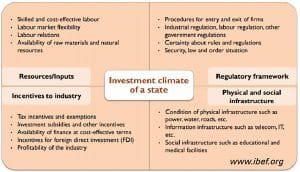
Parameters to evaluate the investment climate of any state airport received 3.97 million passengers and the Varanasi airport received 1.91 million passengers in 2016-17. New airports have been proposed at Gautam Buddha Nagar, Shrawasti and Kushinagar districts. The Taj International Airport is the second international airport proposed to be built in the Delhi-NCR region. This airport’s location will be at Jewar village, Gautam Buddha Nagar district.
- Rail network: The railway network in Uttar Pradesh is the largest in India. The state is well connected to other parts of the country by a rail network spanning over 8,890 km. The major sectors and industries serviced by the railways include agriculture, cement, fertiliser, coal and manufacturing. Various parts of the state are catered to by five of the 16 railway zones in India. These are Northern Railways, North Eastern Railways, East Central Railways, North Central Railways and West Central Railways. Lucknow is the main junction for the Northern and North Eastern Railways. The intra-state rail network is well-developed, connecting the towns and the district headquarters of Uttar Pradesh.
(Source: Indian Railways)
Infrastructure status
Uttar Pradesh is set to see massive infrastructure development, as under the central government sponsored scheme of Atal Mission for Rejuvenation and Urban Transformation (AMRUT), a total expenditure of ₹ 114.21 billion has been allotted to the state for improving basic urban infrastructure. Officials of the union urban development ministry say that the infrastructure development will take place in 61 cities and towns with a population of above 100,000 each by 2019-20. The ministry has approved AMRUT Action Plans for UP for the next three years (2017-20) in one go, involving an expenditure of ₹ 42.39 billion. The state has got the highest allotment in the country under AMRUT.
- Power: Uttar Pradesh Power Corporation Limited (UPPCL) was able to meet its energy demand throughout the state with minimal restrictions and control measures. As per the latest statistics generated by UPPCL, during the year 2015-16, maximum demand met was 14.50GW on 11.11.2015 (maximum demand recorded was 16.98GW on 19.09.2015), and the highest daily energy supply was 303.9MU on 11.06.2015 (maximum demand recorded was 338.7MU on 19.09.2015).
(Source: Uttar Pradesh PowerCorporation Limited) - Telecom: The Uttar Pradesh circle has good telecom infrastructure with all the major players providing services in the state. The state has 37.4 million mobile phone subscribers. UP has a vast postal circle, divided into six regions, namely, Allahabad, Agra, Bareilly, Gorakhpur, Kanpur and Lucknow. The state has about 17,662 post offices. Uttar Pradesh has 3,273 telephone exchanges.
- Urban infrastructure: Average per capita supply of water in the state’s cities is 167lpcd, higher than the desired supply of 150lpcd. All the cities are fully covered by piped water supply systems. Solid waste collection efficiency is 70 per cent, on an average, for all the cities, with Kanpur having 100 per cent efficiency. Medical waste is disposed scientifically in all the cities, except Meerut. Under the Jawaharlal Nehru National Urban Renewal Mission (JNNURM), 33 projects costing US$ 1.17 billion have been sanctioned for various cities. Most of the projects approved are in Kanpur, Lucknow, Varanasi, Allahabad and Agra. Some of the key areas of development are the water supply, solid waste management, sewerage and drainage/storm water drains. All the projects for UP under the JNNRUM are under approval or in the work-in-progress stage. Most of the projects were approved during the period 2007-09.
(Source: JNNURM project details, Ministry of Urban Development) - Industrial infrastructure: The state has a robust industrial infrastructure, including 15 industrial areas, 12 specialised parks, three growth centres and four industrial infrastructure development centres (IIDC). As of June 2017, the state had 19 notified special economic zones (SEZs). Greater Noida Phase-II has 19 per cent land reserved for industrial use.
Business opportunities
The factors driving industries to manufacture in Uttar Pradesh are: industrial infrastructure, which includes growth centres and industrial parks; an extensive railway and road network, availability of a vast work force and incentives offered by the state government. Several manufacturing units have been set up in the industrial areas of Sahibabad and Noida, which enjoy proximity to Delhi and an excellent transportation network with the rest of the country.
- Electronics: Several major multinational companies such as LG Electronics, Samsung and Xerox have their operations in the state. The main incentives for the companies are industrial infrastructure and access to the consumer markets of Uttar Pradesh and the National Capital Region. Most of the companies are located in Noida and Ghaziabad.
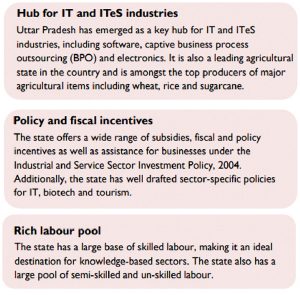
Advantages of investing in Uttar Pradesh - Automobiles and auto components: One of the country’s auto-clusters is located in the Delhi-Gurgaon-Noida-Ghaziabad region, part of which falls in western UP. A centre to provide complete homologation services to tractors, off-road vehicles and diesel generators, set up as per Indian and global standards, as well as driver training, is coming up at Rae Bareli in Uttar Pradesh. The centre is being set up by the National Automotive Testing and R&D Infrastructure Project (NATRIP), for which the land acquisition is almost complete. There will also be a centre of excellence for accident data analysis.
- IT and ITeS: The factors driving the IT and ITeS industry in the state are industrial infrastructure in areas such as Noida and Greater Noida, proximity to Delhi, international connectivity and the talent pool.
Ease of doing business in UP
The UP state government has been taking the right steps to attract investments by providing an enabling environment to set up new industries and expand existing ones. In 2016, the state ranked 14th in the EoDB (ease of doing business) rankings of DIPP (Department of Industrial Policy and Promotion). However, there are a few challenges that investors face that the state needs to address.
In the 2016 EoDB ranking, the state had a score of 84.52 per cent. So even though the state has gone down by four positions from where it stood in 2015, its overall performance has improved from its score of 47.37 per cent in the previous year. The latest ranking reflects that even though the state government has put in great efforts to introduce the EoDB reforms based on the DIPP action plan, there is still scope for further improvement.
The key institutions driving the reforms in the state include the Directorate of Infrastructure and Industrial Development (DIID), the Udyog Bandhu and the Uttar Pradesh State Industrial Development Corporation (UPSIDC). The DIID formulates and implements relevant policies
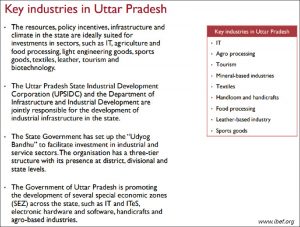
and strategies to facilitate the EoDB in the state. Udyog Bandhu is a three-tiered organisation (operating at the district, divisional and state levels) set up to attract investments to the state and resolve investor grievances. It is the nodal agency for effective implementation of the ‘Single Table System’ in UP. The major functions of the UPSIDC include developing industrial areas, identifying and promoting infrastructure-related and industry-specific projects, land acquisition for large projects, developing integrated infrastructure for industrial townships, etc.
(Source: Ease of doing business in UP: Briefing paper)
The UP government has signed several memoranda of understanding (MoUs) with investors at various investor events, such as the ‘UP Investment Summit’ held in Dubai in 2016, the Investors’ Meet at Mumbai in 2015, the Investors’ Conclave hosted by the state government in 2014, etc. Further, the government has set up a robust and investor-friendly policy framework, and has been laying emphasis on simplifying the procedures and processes to be followed by industries for setting up or expanding their businesses.
Policies and incentives
The IT and electronics sector has been contributing immensely to the state’s industries with the presence of companies like TCS, IBM, Wipro, STMicroelectronics, etc. Global giants like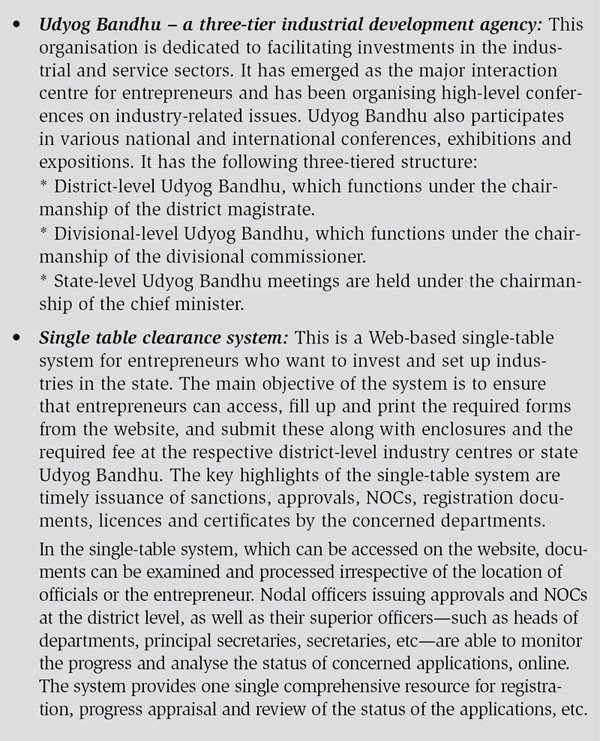 Samsung, LG Electronics and HCL established their UP operations two decades ago.
Samsung, LG Electronics and HCL established their UP operations two decades ago.
The electronics manufacturing sector is one of the largest and fastest growing industries in the world with a turnover of US$ 1.75 trillion, which is expected to reach US$ 2.4 trillion by 2020. The demand in the Indian electronics market alone is expected to reach US$ 400 billion by 2020. With the present growth rate, India can only manufacture goods worth US$ 100 billion by 2020. To address the demand-supply gap, the Indian government plans to transform India into a global ESDM hub to cater to both domestic and global demand.
Aligning with the national vision, Uttar Pradesh is growing fast in the ESDM sector with new entrants like Oppo, Lava, Intex, Vivo, etc, along with several components manufacturers, setting up their units in the state.
Policy updates – All that you need to know
To accelerate the development of the ESDM ecosystem, the UP Electronics Manufacturing Policy has declared the Noida, Greater Noida and the Yamuna Expressway region as an Electronics Manufacturing Zone (EMZ), and all the incentives under the policy shall be applicable to all units setting up their bases in this zone. The EMZ already has seamless
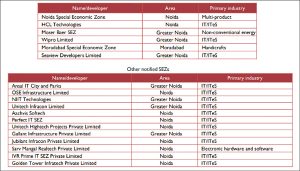
connectivity, state-of-art infrastructure, a logistics hub, 24×7 water and power availability, social infrastructure like international schools, hospitals, proximity to the international airport as well as to the DMIC and EDFC corridors. This will lead to exponential growth in the ESDM units in these zones, which will not only boost the state’s economy but also create large scale employment.
Vision of the UP Electronics Manufacturing Policy
- To promote the growth of the electronics manufacturing industry in the state by providing a conducive environment and to position Uttar Pradesh as the most preferred investment destination
- To provide single window assistance for the successful establishment of ESDM units in the state
- To build a world class ecosystem covering R&D, product design, assembly, testing and engineering for electronics manufacturing
- To promote skills development for the workforce in the electronics sector, which can boost employment opportunities within the state
Objectives of the policy
- Establishment of electronics manufacturing clusters/ESDM parks in the state
- To attract investment in the electronics manufacturing sector in the state
- To focus on establishing a fab (semiconductor) unit in the state
- To establish ESDM parks for domestic/foreign investors in the state
- To promote and develop employment opportunities within the state
- Augment the Gross State Domestic product (GSDP) of Uttar Pradesh
Policy implementation strategy
With the new Electronics Manufacturing Policy, the state government aims to make Uttar Pradesh an electronics manufacturing hub by establishing a conducive ecosystem for the electronics system design and manufacturing (ESDM) sector, where anchor units and components manufacturers shall work together.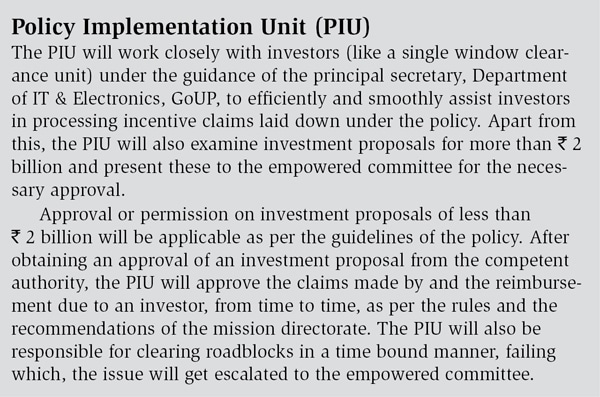
The policy plans to attract investments of ₹ 200 billion in the ESDM sector and generate employment for 300,000 people by 2022. There will be a drive to establish electronics manufacturing clusters (EMC)/ESDM parks within the state. These EMCs/ESDM parks will help in:
- Creating innovative and competitive business zones based on knowledge, people-led innovation and global networking
- Offering high capacity for monitoring and managing environmental issues
- Improving city transportation and more secure urban spaces
- Providing basic infrastructural facilities like land, power (uninterrupted 24×7 supply of quality power), water, roads, etc.
Incentives being offered
A number of incentives have been granted for the EMC/ESDM parks and to individual ESDM units being set up in the state’s Electronics Manufacturing Zone (EMZ) till the period ending on March 31, 2022. There are also financial incentives up to a limit of ₹ 200 billion from the competent authority (excluding the fab unit), for ESDM units.
A state level empowered committee under the chairmanship of the chief secretary will monitor the implementation and successful execution of the policy within the state. The empowered committee will decide on any extensions of the policy period duration and increases in the amount of financial incentives mentioned above. It will also decide upon the disbursement of financial incentives in other EMZs.
Other benefits
- Reimbursement of up to 5 per cent of fixed capital expenditure (other than on land) for ESDM units, to be used for training employees on technology in the fields of embedded system design, VLSI design, PCB design and manufacturing, chip manufacturing, TFT manufacturing, etc, subject to a maximum of ₹ 250 million per unit. This reimbursement aims to cover 50 per cent of the cost incurred on training, subject to a maximum of ₹ 250,000 per employee for international training and ₹ 100,000 per employee for domestic training on completion of six months of employment (for UP domicile workers) for units established inside the EMZ. These incentives shall be applicable for ESDM units with investments of over ₹ 3 billion, evaluated on a case-to-case basis and shall not be more than 100 per cent of the fixed capital from all the resources, unless stated otherwise in the policy.
- Aligning the UP Skill Development Mission with the required skill sets for the electronics industry, to pass on the benefits of the scheme to those eligible.
- Align the skills to be developed in the ESDM sector with the budget allocated by DeitY.
Permission will be provided to have 24×7 operations and employment of women in all three shifts.
Private ESDM parks
Domestic and foreign investors in the ESDM sector willing to establish their units in ESDM parks, developed by private firms shall be given the following incentives:
- Allowed a minimum area of 50 acres
- Twenty-five per cent land rebate on the prevailing rates shall be provided on purchase of land from state agencies
- Developers shall get outside infrastructural development support from authorities
- Single window assistance from the concerned authority, and a nodal officer will be nominated for every park
- Interest subsidy: Up to 60 per cent of annual interest for seven years on loans taken for building infrastructure (road, electricity, water, dormitories, etc) in the industrial parks, subject to a limit of ₹ 100 million per year with an overall ceiling of ₹ 500 million per park
- Hundred per cent exemption of stamp duty for the purchase/lease of land on the first transaction (i.e., authority to developer/SPV) and 50 per cent on the second transaction (i.e., developer/SPV to ESDM units)
UP’s success story, at a glance
The scaling up of the business ecosystem in the state is being spearheaded by some big brands. While many firms are already active in UP, a few more are considering entering the state and further expanding the market.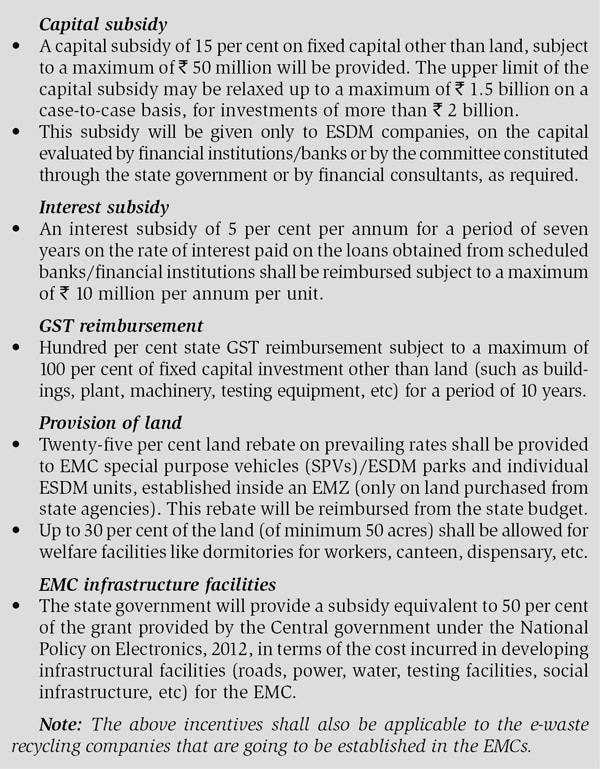
LG Electronics and Micromax are among a host of companies to have expressed interest in land developed by the Delhi-Mumbai Industrial Corridor Development Corporation (DMICDC) in Greater Noida to set up units. DMICDC is still in the process of getting applications from potential investors to lease out land there and will soon finalise the list of eligible companies. While Micromax has formally applied for five hectares of land, LG has evinced interest in acquiring 10 hectares. The entry of established players like Micromax and LG is expected to give a much-needed push to the DMICDC projects and reflects the growing importance of the corridor, the concept of which was mooted a decade ago and cleared by the Cabinet in 2011.
How UP fares on the solar front
The solar sector of the state has immense potential to bring about economic and environmental well-being. ReNew Power Ventures has inked a pact with the Uttar Pradesh government to invest ₹ 80 billion for 1.2GW of renewable energy capacity, a move that can create 12,000 jobs in the state. The MoU was signed as part of the UP Investors Summit 2018, held in February this year, in the presence of the UP CM, Yogi Adityanath.
In February 2018, Amplus Energy Solutions signed a memorandum of understanding (MoU) with the UP government to set up 500MW of solar capacity in the state, subject to an investment of ₹ 22 billion over the next five years.
SunSource Energy, a solar EPC player in India, is boosting its portfolio with plans to develop a 200MW solar park in Uttar Pradesh entailing an investment of ₹ 9 billion. The company has also received funding from the State Bank of India-led Neev Fund, which will help it reach its target of 1.5GW project capacity by 2025.
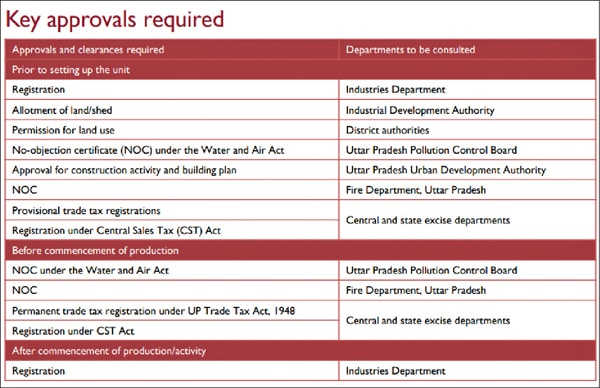
Industry body ASSOCHAM has urged the Uttar Pradesh government to prepare three special economic zones (SEZs) for solar energy development and try to encourage private players in the field. State-owned gas utility GAIL India Ltd said it has commissioned the country’s second largest rooftop solar power plant in UP. The firm has installed a 5.76 MWp solar plant at its petrochemical complex at Pata in Uttar Pradesh.
UP’s ESDM sector
The ESDM environment in UP is creating opportunities for better trade, more manufacturing and higher employment. It is an industry full of initiatives and investments, and can drive India towards its vision of becoming a manufacturing centre.
Uttar Pradesh is on track to become an electronics hub as investments of more than ₹ 260 billion were allocated during the UP Investors Summit last month. “UP got a new identity as an electronics hub during the Investors Summit. Besides IT companies, electronics manufacturing units have also expressed their desire to invest in the state,” said additional chief secretary, Department of IT and Electronics, Sanjiv Saran.
With many business units set up by some international smartphone producers, and with many more investing for business purposes, UP offers a lucrative market in this vertical. Let’s look into some of the advancements in this area.
The Centre has approved investments worth ₹ 67.74 billion from Samsung and Oppo, combined under the MSIPS policy for the state. Speaking during the UP Investors Summit 2018, Electronics and IT Minister Ravi Shankar Prasad said that there were only two mobile manufacturing facilities in India in May 2014 but the number has increased to 118 now, of which 54 are in Noida and Greater Noida, in Uttar Pradesh.
Chinese smartphone maker Oppo has been given the green clearance to set up a mobile manufacturing unit in Greater Noida at a cost of ₹ 22 billion. Oppo wants to set up a smartphone manufacturing unit in 110.04 acres in Greater Noida, Uttar Pradesh. The project will comprise factories, offices, dormitories, canteens and play areas. The state electricity
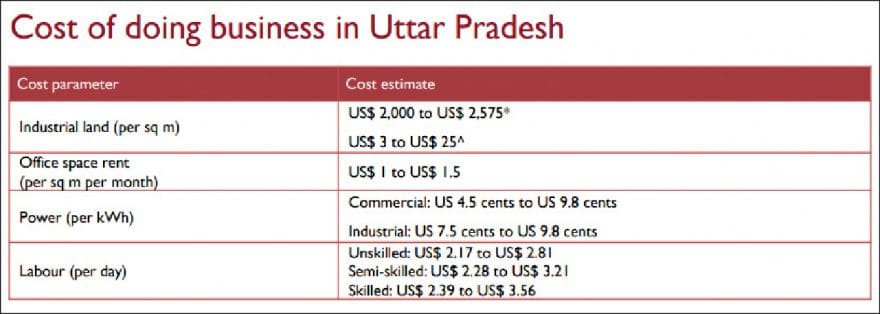
board will supply power to the proposed project, which is expected to generate direct and indirect employment opportunities for both skilled and unskilled labour during the construction and operation phases.
Samsung has expressed its desire to further invest ₹ 491.5 billion in its production plant. The investments will be facilitated over the next three years. The proposal for the investment has also received the green signal from the Uttar Pradesh government. The new plant in Noida will help address the rising demand for Samsung’s products in the Indian market. Telecom solutions company Spice is also looking at setting up a mobile handset manufacturing unit in Noida, keeping in mind that Noida and Greater Noida have emerged as the country’s mobile phone assembly hub with brands such as Lava, Intex and Karbonn also setting up their units there.
The telecom sector is also witnessing many improvements in UP. Government bodies as well as private players are putting in extensive efforts to bring about a change. Jio Infocomm is to invest a fresh ₹ 100 billion in Uttar Pradesh over the next three years and will make available 20 million Jio Phones in the next two months, in the state.
The healthcare domain also provides good business opportunities in UP. Samsung India has partnered with the Uttar Pradesh government to set up 20 new smart healthcare centres across the state to provide healthcare equipment. The smart healthcare programme aims to offer affordable and quality healthcare to patients from the economically and socially weaker sections of society. The company will provide advanced equipment such as ultrasound and digital radiology (X-ray) machines manufactured by it along with LED TVs, air conditioners and refrigerators to select government hospitals across the state. A Memorandum of Understanding (MoU) was signed between Samsung India and the Department of Medical Health and Family Welfare, government of Uttar Pradesh for the same.
Seeing so many success stories, it can well be concluded that the industrial transformation going on in Uttar Pradesh could prove to be the perfect landscape for businesses to flourish.
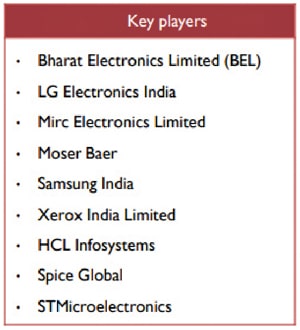
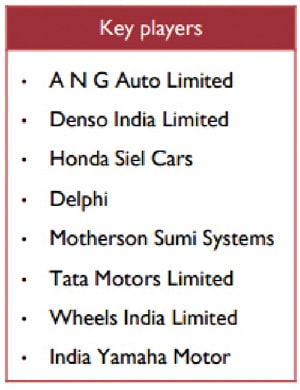
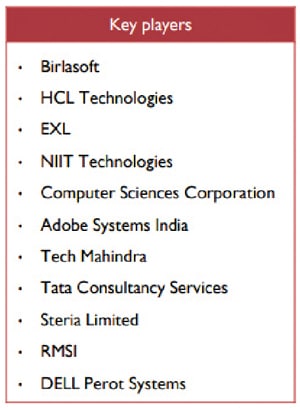
Areas for improvement
UP still has a long way to go in terms of providing the best business-friendly environment to investors.
- Issues related to the single window system: Concerns have been raised by the industry regarding the ineffective functioning of the single window system for clearing projects, which was introduced by the UP government. The timelines specified in the Act and in the government orders are not being adhered to. Moreover, there are several windows behind the single window, resulting in processes becoming cumbersome.
- Dysfunctional high-powered committee of Udyog Bandhu: To iron out the difficulties faced by entrepreneurs and to suggest possible ways to simplify procedures, a high-powered committee has been constituted. The meetings of the committee are held under the chairmanship of the CM. The other permanent members of the committee include the state level industry associations, principal secretaries and secretaries of different departments related to industries. The committee, however, has remained dysfunctional for the last couple of years.
- Lack of institutional memory: Frequent bureaucratic transfers pose a key challenge in terms of maintaining the continuity within the system.
- High cost of power: The industries have been complaining of high industrial tariffs in the state, due to high cross-subsidies. This increases the overall cost of doing business.
- Access to finance: The micro, small and medium enterprises (MSMEs) face challenges in getting access to finance from both the state finance corporation and the banks.
- Inadequate dissemination of information to industries: The information regarding EoDB reforms has not been effectively disseminated to the industries. The problem persists more in the case of the MSMEs who have no access to information regarding the relevant policies and regulations that are in place, and therefore resort to hiring middlemen to fulfil simple procedures.
Moving forward
The vastness and internal cultural diversity in UP makes governance a difficult task. Also, the state is highly politically sensitive, which makes policy making difficult. Despite the challenges, UP has managed to score 84.52 per cent for EoDB reforms based on DIPP’s Action Plan. However, UP has a long way to go in providing a business-friendly environment to investors. The state primarily needs to establish an effective system of checks and balances to allow investors to benefit from its policies. Uttar Pradesh must learn from the success of other states as well as from its own mistakes to become an attractive destination for the Indian and global electronics industry.




























